Accurate Miniatures 1/48 P-51A Mustang
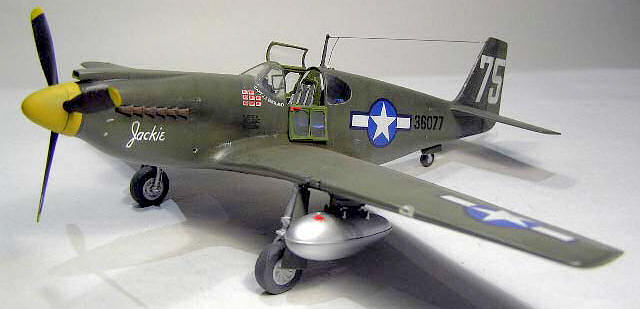
311th FBG was composed of 528th
and 529th FBGs, equipped with
A-36s, and 530th, on P-51As, part
of the controversial command held by Claire Chennault. Initially based at
Assam,
India-Burma border, 530th took part
in the raids on
Rangoon
in  November,
1943, fitted with long range drop tanks and using Cox’s Bazaar as forward base.
The Japanese were not very impressed by the P-51As, considering it little better
than the P-40. The only plane they feared (in a way, for most were eager to
clash with them) was the Spitfire Vc.
November,
1943, fitted with long range drop tanks and using Cox’s Bazaar as forward base.
The Japanese were not very impressed by the P-51As, considering it little better
than the P-40. The only plane they feared (in a way, for most were eager to
clash with them) was the Spitfire Vc.
Probably the most distinguished Allison Mustang
ever, this machine was the original “Spirit of Universal” as a presentation
machine paid by the workers of the Universal Engineering Company,
Frankensmith,
Michigan.
It was issued to Capt.
England
in
India,
late 1943, being christened after his wife. Contradictory versions have that
England
scored two or eight victories on this machine, a problem composed by the
existence of pictures showing “Jackie” with and without the “75” marking and two
victory markings. The plane was still flying in late 1944, when Lt. William
Griffith used it to win the Silver Star.
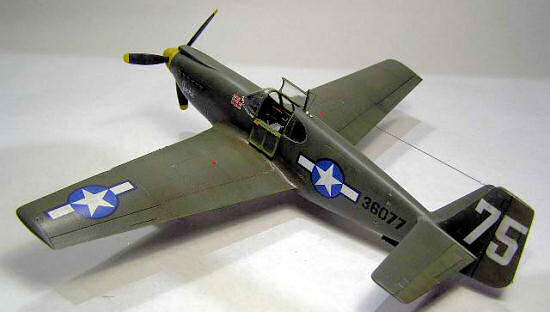
All
previously said in the feature on the A-36 applies to this kit, even though this
is a “second generation” Allison Mustang kit, and, as such, molded in Light Grey
plastic (the P-51 and the A-36 are from the “first generation”, molded in Olive
Drab plastic; the second is composed of this one and the Mustang Ia). They are
good, honest kits depicting a badly unrepresented aircraft, sensibly laid and
essentially quick and fun to build. However, close inspection reveals an
alarming scarcity and inaccuracy in the details – this is not to say that if
built OOB they do not look good, but that if there is plenty of scope for making
them better and more detailed, at your own risk.
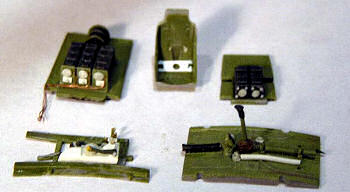 First
thing was gathering some sources to detail the cockpit. The cockpit is generic
to all Allison P-51 kits, and therefore lacking accurate detail.
Both the sidewalls and the floor were extensively modified, mostly with
scratchbuilt items, including the reconstruction of the consoles, radio
equipment, armor, gunsight and floor detail. The seat came from an Eduard PE set
(bless them, they included two in their set), after I had laboriously modified
the kit’s, only to lose it forever; the harness is generic. T
First
thing was gathering some sources to detail the cockpit. The cockpit is generic
to all Allison P-51 kits, and therefore lacking accurate detail.
Both the sidewalls and the floor were extensively modified, mostly with
scratchbuilt items, including the reconstruction of the consoles, radio
equipment, armor, gunsight and floor detail. The seat came from an Eduard PE set
(bless them, they included two in their set), after I had laboriously modified
the kit’s, only to lose it forever; the harness is generic. T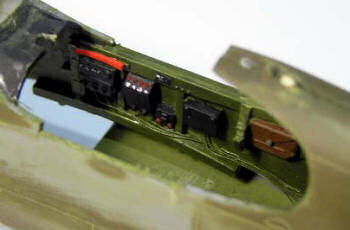 he
interior was painted in US Interior Green FS 34151, using Xtracolor paints. The
seat was painted NMF to provide contrast, though it is seen either way in
pictures.
he
interior was painted in US Interior Green FS 34151, using Xtracolor paints. The
seat was painted NMF to provide contrast, though it is seen either way in
pictures.
The rest of the construction posed no problem; this time, the canopy
provided was used, though it is a bit thick; some mimickry of the opening
mechanism was concocted. The wing was equipped with a landing light. The paddle
blade prop is again correct for a P-51A (though not for a P-51 or Mustang Ia).
AM has made no attempt of detailing the radiator exit ramp, and neither did I,
again; this is very prominent part of the airframe, and there is no easy way of
doing anything about it. In the end I chose to differentiate it by painting it a
lighter shade and to weather it accordingly to a moving part.
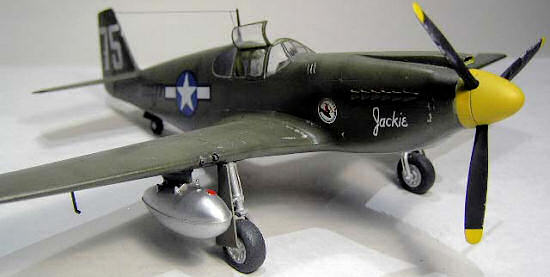 The
instructions have you paint the model in “Olive Drab FS
34087”
(nowadays 34088) and “Neutral Grey FS 36270” (in fact, the model had been
originally painted like
that; remains of the incorrect, lighter colours can still be seen in the
assembly pictures). Instead, I used my favourite color for OD nº 41, Humbrol 108
“RFC Green” (Robert Archer’s choice) and for the NG nº 43, the White Ensign one.
Spinner was painted Yellow; pictures show it a light colour, which could have
been White or even NMF, both also used. Drop tanks were left NMF.
The
instructions have you paint the model in “Olive Drab FS
34087”
(nowadays 34088) and “Neutral Grey FS 36270” (in fact, the model had been
originally painted like
that; remains of the incorrect, lighter colours can still be seen in the
assembly pictures). Instead, I used my favourite color for OD nº 41, Humbrol 108
“RFC Green” (Robert Archer’s choice) and for the NG nº 43, the White Ensign one.
Spinner was painted Yellow; pictures show it a light colour, which could have
been White or even NMF, both also used. Drop tanks were left NMF.
Weathering was achieved by a heavy preshading in a dark concoction,
general irregular mottle-painting and picking some panels by masking with a
lighter shade. After that some chipping was made with a silver pencil, then the
same dark juice was flowed on the surfaces as a wash and also airbrushed, and
some pastel powder finished the business. I usually strive for a “well used, but
not dilapidated” look which is badly captured in photos of models, often looking
too plain.
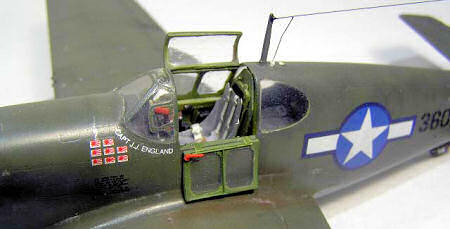 Well,
for all the usually accurate, careful research typical this company, decals are
left rather wanting in this one. The people at AM obviously couldn’t get a
picture of the right side of the airframe (one can be seen on page 18 of the
Osprey book), though they indeed acknowledged the different style on the tail
“75s”. The decal sheet only provides one “Jackie” (for the left side, while the
right side shows another) and also lacks the unofficial emblem of the 530th
(a diving bird), also seen on the right side. I solved the problem by using a
“Jackie” decal from another kit and sourcing the emblem from the Ministry of
Small Aircraft Production “Allison Mustangs” sheet. National insignia came from
an Aeromaster sheet. AM depicted eight victory flags, Cpt. England’s tally, but
in the pictures I ve seen only two are shown.
Well,
for all the usually accurate, careful research typical this company, decals are
left rather wanting in this one. The people at AM obviously couldn’t get a
picture of the right side of the airframe (one can be seen on page 18 of the
Osprey book), though they indeed acknowledged the different style on the tail
“75s”. The decal sheet only provides one “Jackie” (for the left side, while the
right side shows another) and also lacks the unofficial emblem of the 530th
(a diving bird), also seen on the right side. I solved the problem by using a
“Jackie” decal from another kit and sourcing the emblem from the Ministry of
Small Aircraft Production “Allison Mustangs” sheet. National insignia came from
an Aeromaster sheet. AM depicted eight victory flags, Cpt. England’s tally, but
in the pictures I ve seen only two are shown.
It is a nice model of a nice and rather unsung aircraft, often seen as
an early, half-failed predecessor to the classic Merlin Mustang. It can be built
OOB for a quick, trouble-free model, or worked up and rendered a good replica.
“P-51 Mustang”, Bert Kinzey, Detail and Scale Publishing
- “US
Army Air Corps Color Guide”, Don Archer, Monogram
Publishing
- “Straight down – The A-36 Dive Bomber in combat”, Peter C. Smith,
Crecy Publications
- Squadron Walkaround “Allison Mustangs”, Squadron Signal
Fernando
Rolandelli
August 2012
Copyright ModelingMadness.com. All rights reserved. No reproduction in part or in whole without express permission from the editor.
If you would like your product reviewed fairly and fairly quickly, please contact the editor
or see other details in the
Note to
Contributors.
Back to the Main Page
Back to the Review Index Page 2024
November,
1943, fitted with long range drop tanks and using Cox’s Bazaar as forward base.
The Japanese were not very impressed by the P-51As, considering it little better
than the P-40. The only plane they feared (in a way, for most were eager to
clash with them) was the Spitfire Vc.
he
interior was painted in US Interior Green FS 34151, using Xtracolor paints. The
seat was painted NMF to provide contrast, though it is seen either way in
pictures.